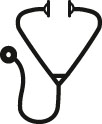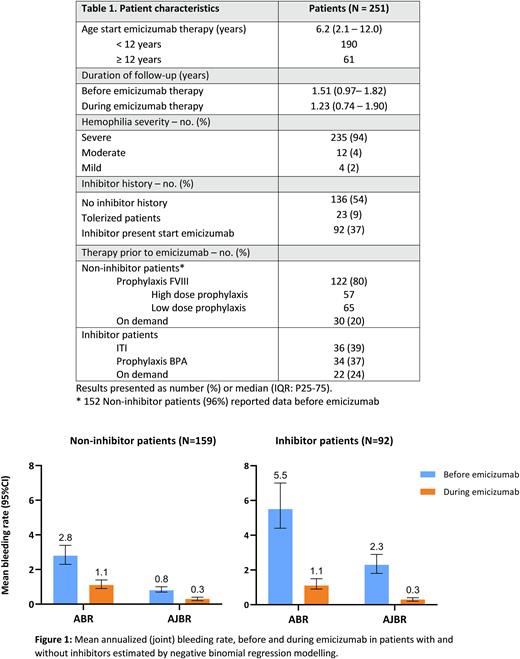Abstract

Background: Despite the rapid uptake of emicizumab in the pediatric hemophilia A (HA) population, real-world data on emicizumab safety and efficacy outcomes are limited to the HAVEN-2 trial (N = 85) and single center cohort studies.
Aim: To report on bleeding and safety in children and adolescents with HA receiving emicizumab prophylaxis in a large prospective multicenter cohort study.
Methods: Data were extracted from the ongoing PedNet Registry (Clin.gov.trial-NCT02979119; date of extraction: Jan 2022). Patients were included if they had a diagnosis of congenital hemophilia A with a baseline factor FVIII up to 25% and were < 18 years old at start of emicizumab. Patients were required to have maintenance therapy of emicizumab and bleeding data available for a minimum of 4 weeks. Patients with concomitant coagulopathies were excluded (N = 2).
Bleeding data were compared during emicizumab to bleeding data before emicizumab up to a maximum of two years prior to the start of emicizumab. Patient characteristics were summarized as numbers (%) and median with IQR (P25-P75). Mean annualized bleeding rate (ABR) and annualized joint bleeding rate (AJBR) were estimated and compared between prophylactic regimens by negative binomial regression modelling.
Results: 251 patients were included from 30 hemophilia treatment centers, see Table 1 for patient characteristics. The median age at start of emicizumab therapy was 6.1 years (IQR: 2.1 - 12.0). Median follow-up time before emicizumab was 1.51 years and during emicizumab was 1.23 years with a total of 361 patient years reported on emicizumab therapy. Most patients (94%) had severe HA and 76% of the patients were younger than 12 years at start of emicizumab therapy. Approximately one third (37%) of the patients had an inhibitor at start of emicizumab with a median peak titer of 128 BU/ml (IQR: 34 - 600).
The ABR and AJBR significantly improved during emicizumab therapy in patients with and without inhibitors, see Figure 1. In patients without inhibitors the mean ABR reduced from 2.8 prior to emicizumab to 1.1 during emicizumab (p < 0.001), while the AJBR reduced from 0.8 to 0.3 (p < 0.001). Similar results were seen in patients with inhibitors. The mean ABR reduced from 5.5 to 1.1 (p<0.001), while the AJBR reduced from 2.3 to 0.3 (p<0.001).
In this cohort, two serious adverse events and six adverse events were reported during emicizumab therapy in eight patients (3% of total cohort). Serious adverse events included one death unrelated to emicizumab therapy (retroperitoneal bleed in a baby treated with LMWH for CVL thrombosis) and one patient developed anti-drug antibodies without breakthrough bleeding, who continued emicizumab therapy. Non serious adverse events were all related to local injection site reaction in six patients. No TMA or thrombotic events were observed.
Conclusions: This large cohort study with prospectively collected data showed improved bleeding control compared to previous therapy and a favorable safety profile during emicizumab treatment in pediatric patients.
Disclosures
Van Geet:Pfizer: Research Funding; Bayer: Research Funding; CSL Behring: Research Funding; Novo Nordisk: Consultancy. Kenet:ASC Therapeutics: Consultancy; Opko Biologics: Consultancy, Research Funding; Shire: Research Funding; Alnylam: Research Funding; BPL: Consultancy, Research Funding; Sanofi-Genzyme: Consultancy, Honoraria; BioMarin Pharmaceutical Inc.: Consultancy, Honoraria; UniQure, SPark, Sobi, CSL: Honoraria; Novo Nordisk: Consultancy, Honoraria; Takeda: Consultancy, Honoraria; Roche: Consultancy, Research Funding; Bayer: Consultancy, Honoraria, Research Funding; Pfizer: Consultancy, Honoraria, Research Funding. Fischer:NovoNordisk: Honoraria; CSL Behring: Honoraria; Freeline: Consultancy; Sobi: Consultancy; Roche: Consultancy; NovoNordisk: Consultancy; CSL Behring: Consultancy.
Author notes
 This icon denotes a clinically relevant abstract
This icon denotes a clinically relevant abstract
Asterisk with author names denotes non-ASH members.


This feature is available to Subscribers Only
Sign In or Create an Account Close Modal